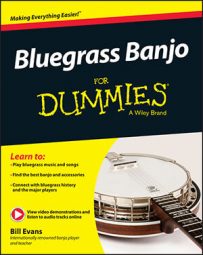The picking‐hand fingers strike the same strings consecutively in single‐string banjo, and this is one of the biggest challenges of mastering this playing technique. Most players use the thumb and index fingers to do this, much the same way as guitar and mandolin players use a flatpick in an up‐and‐down motion to get a similar result. More recently, banjo players have incorporated the middle finger, using parts of roll patterns to play single‐string passages.
It’s essential to get comfortable with the picking‐hand moves as you embark upon your single‐string explorations. Keep the following tips in mind as you tackle the following exercises:
Maintain the same basic picking‐hand position that you use for roll‐based playing. Single‐string style is usually used in conjunction with roll‐based playing. In the course of a song, you’ll need to shift back and forth between both ways of playing, so it makes sense to use the same picking‐hand position for both styles.
Strike strings with equal volume with the thumb, index finger, and middle finger. To get a flowing sound from your single‐string picking hand, you’ll want to strike the strings with equal volume with all fingers. This is trickier than it sounds because the thumb is accustomed to hitting the strings with more force. Practice single‐string passages slowly at first to make sure you’re pulling the same volume from each finger.
Play notes in an even rhythm. Your single‐string efforts will sound smoother if you let each eighth note equal every other note in rhythmic duration with no bounce or swing feel added to your playing. Even rhythm plus equal volume gives your single‐string playing the poise and balance you’ll need to execute long, complex lines with your fretting hand.
Basic single‐string technique
The basic single‐string picking‐hand stroke sounds simple: Strike a string with your thumb, strike the same string with your index finger, and then repeat. That’s it! However, things get a bit more complicated as you shift this picking sequence from one string to another.

These single-string examples will get you comfortable with shifting strings with the basic single‐string sequence. Note that in the example below, you’ll move more quickly between strings, much as you’ll encounter when playing real tunes.

As you move from the fourth to the first strings and back again in these examples, try shifting your hand position ever so slightly as you move from string to string by pivoting on the ring and pinky fingers. The goal is to center the thumb and index finger over each string so that you can use the same precise movement and angle to strike each string (you don’t want to have to reach farther with your thumb to play the first string than the fourth string, for instance).
Don’t be surprised if you hear a more balanced tone from your single‐string efforts after you get used to striking the strings in this way.
Single‐string crossovers
Your fingers have to go where the melodies take them, and there are times when you need to pick a lower string with your index finger just after your thumb has done its thing on a higher string.

You’ll frequently encounter single‐string crossovers, but they don’t necessarily come naturally to the picking hand. It makes sense to isolate this particular skill so that you’re ready for it when you encounter it in songs.

These examples show you how it’s done. Note that each successive exercise gets a bit more complex, but the picking hand maintains the steady alternation of thumb and index notes throughout, regardless of what string is being played. This is an important aspect of most of what you play in single‐string style, so don’t hesitate to “put the thumb to it,” as Ralph Stanley likes to say.

Alternating thumb rolls in single‐string style
When adding the middle finger to your picking‐hand ingredients, you can cook up some spicy single‐string phrases that take advantage of the roll patterns that you already know. The alternating thumb roll, with its basic sequence of T–I–T–M, contains the essential ingredients of basic single‐string technique, with the middle finger giving the index finger a momentary break in the action.

The examples below show you two ways that you can use the alternating thumb roll in single‐string banjo. Note that in the following tab, the middle finger is called into action when moving to a higher string. This is the way that most professional players use the middle finger in single‐string technique.

Forward rolls in single‐string style
Forward rolls are just the things to use in single‐string style when you need six notes in a measure, as in an Irish jig. To play in 6/8 time, you count “ONE‐two‐three‐FOUR‐five‐six” with a bit of an emphasis on the “one” and “four.” This driving rhythm is a great match for a standard forward roll sequence of T–I–M.

